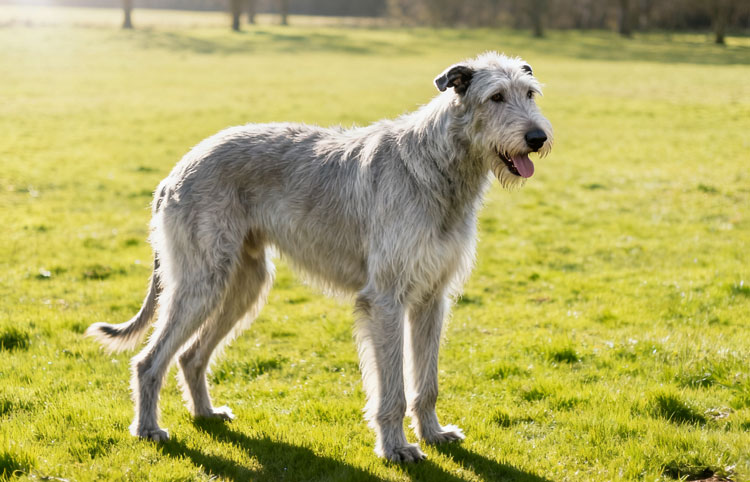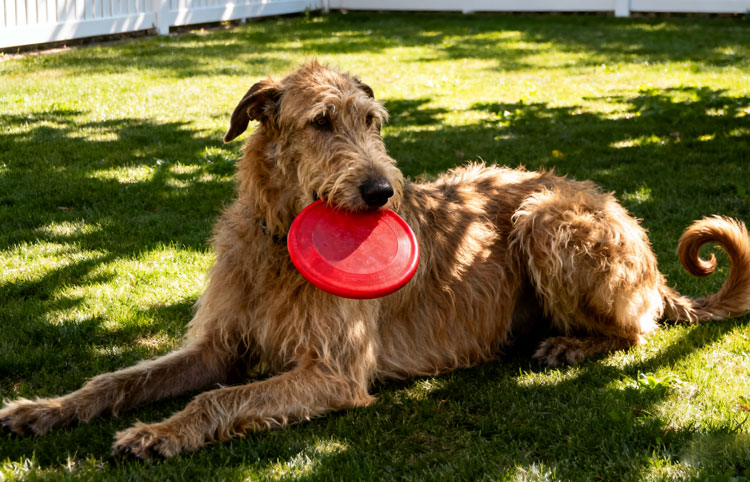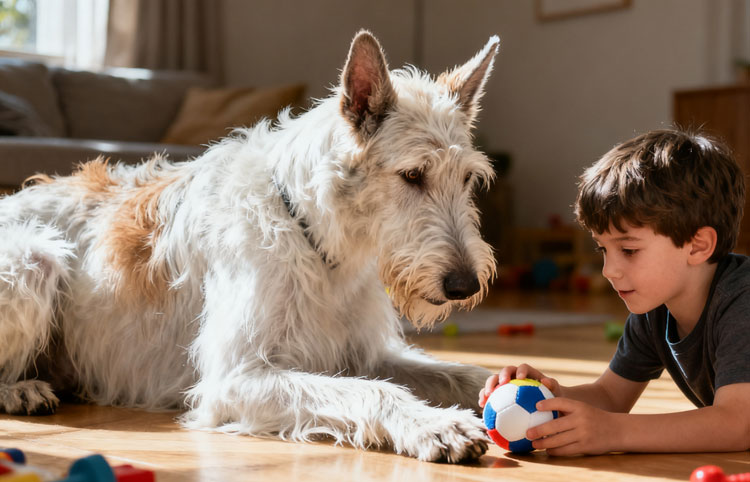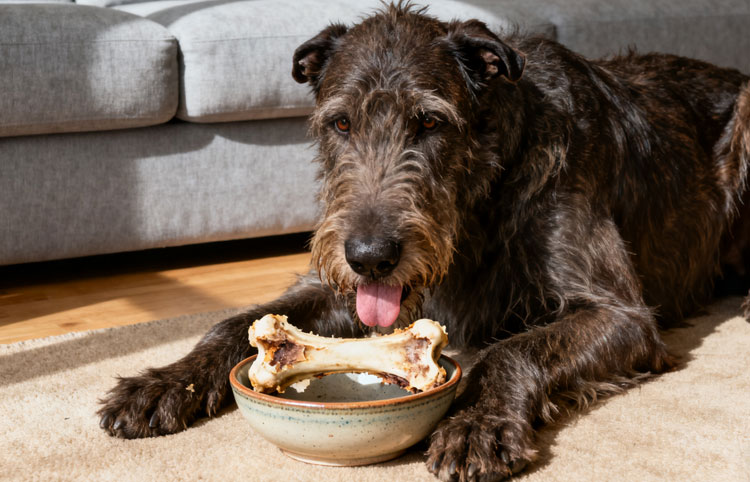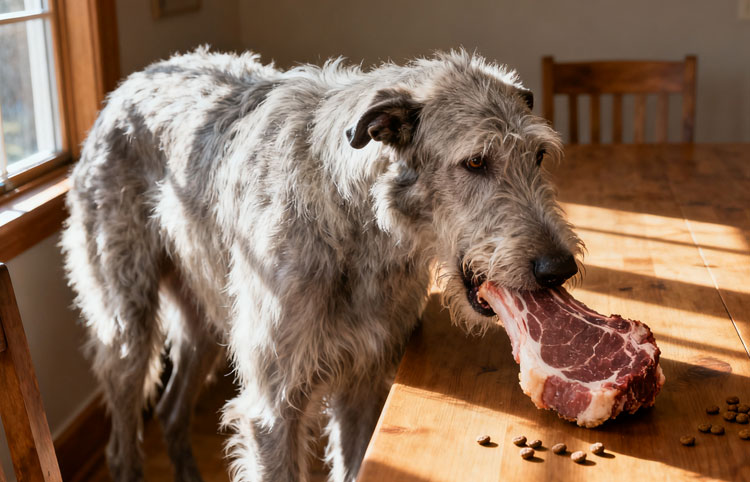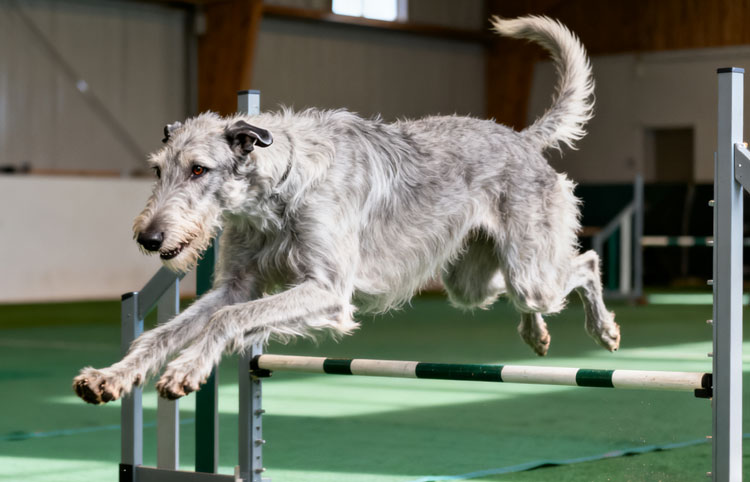Irish Wolfhound Health Care and Breeding Guide
Those who have encountered the Irish Wolfhound are often struck by its imposing yet graceful stature. As an iconic figure among the world’s tallest hounds, this breed holds a special place in the hearts of the Irish people, long regarded as the nation’s dog. At major ceremonies, one invariably sees their dignified presence. Despite its size, it is far from a clumsy “big oaf.” Power and agility are perfectly balanced in its build, which is precisely why it was historically employed in wolf hunts. Wild wolves are formidable opponents, and few domesticated dogs can truly match their ferocity. Yet the Irish Wolfhound has proven itself among the most formidable fighters in the canine world. Today, however, it has shed its “wolf-hunting” edge, evolving into an exceptionally large family companion dog. Its temperament is remarkably gentle, especially toward children, displaying extraordinary kindness and patience.
I. Appearance of the Irish Wolfhound
Classified as a mammal belonging to the order Carnivora, family Canidae, and genus Canis, the Irish Wolfhound possesses a long, sleek body. Its skeletal structure is balanced and sturdy, with well-defined, full muscles showing no hint of excess bulk. The Irish Wolfhound’s head is elongated, featuring a gently arched forehead that is distinctive yet not overly prominent. Its muzzle is long and tapers slightly at the tip, giving it an efficient appearance. The ears are relatively small, lying close to the head with an elegant grace. The limbs are thick and powerful, effortlessly supporting the large frame. The coat feels coarse and sturdy to the touch, though the hair above the eyes and along the jawline grows longer, creating natural layers. Eyes are oval-shaped with pure black eyelids, always conveying a gentle expression. Coat colors are diverse—gray, red, black, pure white, fawn, and wheaten—each shade accentuating its unique character.
II. Irish Wolfhound Temperament
Tracing its origins, the Irish Wolfhound first emerged in Ireland. Over time, you’ll notice its remarkably composed demeanor—even amidst household commotion, it rarely becomes flustered or noisy, possessing a temperament as gentle as a “gentle giant.” The Irish Wolfhound maintains keen focus in daily life. At the slightest unfamiliar sound, it instantly becomes alert, revealing courage in its very bones. However, its reaction speed and ability to grasp complex commands are indeed slightly slower than some smaller breeds, requiring extra patience during training. The Irish Wolfhound is exceptionally friendly toward people. It willingly seeks closeness with both family members and familiar friends, showing unwavering loyalty and deep affection toward its owner. When interacting with children, it instinctively moves more slowly, careful not to bump into them. Often, it will choose one family member to form an especially close, dependent bond with—always accompanying that person on walks or resting by their side. Additionally, it has an innate love for activity. If it doesn’t get out for a walk each day, it will appear listless. This is something owners must remember.
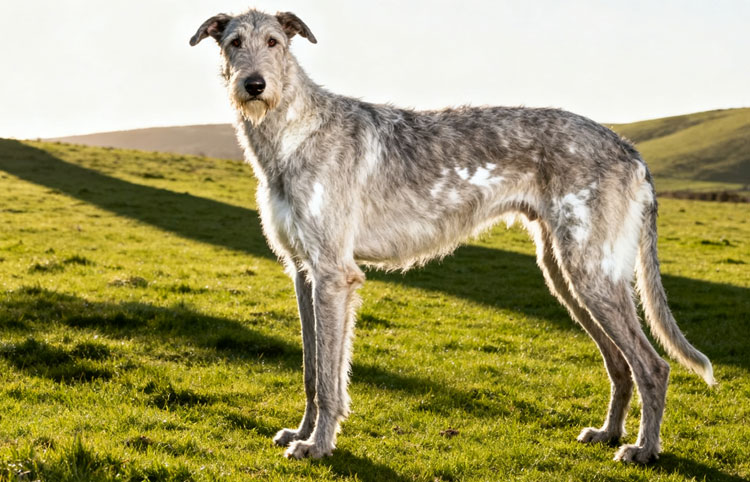
III. Irish Wolfhound Pricing
A standard Irish Wolfhound puppy without exceptional pedigree documentation typically costs between $120 and $300. A puppy with basic pedigree records generally costs around $600. For those with exceptionally pure bloodlines, the price can reach approximately $1,500.
IV. Irish Wolfhound Lifespan
Although the Irish Wolfhound ranks among the world’s tallest dog breeds, its lifespan is relatively short, averaging only 6 to 8 years. This means they accompany their owners for a much shorter time than many other breeds. Therefore, cherish every moment spent together during the time you have with your Irish Wolfhound.
V. How to Select an Irish Wolfhound
1. Body Structure: Male Irish Wolfhounds must have a shoulder height of at least 76 cm (29.9 inches), while females should be no less than 71 cm (27.9 inches). This is the fundamental standard. Additionally, observe their physique—it should be long and powerful, with evenly distributed muscles and no excess fat, avoiding a bulky appearance. When running, their movements should be fluid and natural, without any stiffness.
2. Head: The Irish Wolfhound’s head should be long and narrow, not overly broad. The muzzle is deep, with pronounced lines visible from the side. Ears are rose-shaped, small in size, and lie close to the head. The eyes should be gentle yet determined, neither timid nor fierce.
3. Check the coat: Run your hand through the fur. It should be coarse and wiry, resistant to matting. Common colors include gray and brindle. Crucially, there should be no excessive shedding. Part the fur to examine the skin beneath—it should be smooth, free of dandruff or rashes.
4. Assess Temperament: Speak to the puppy in a gentle tone and offer light strokes. If it approaches willingly without aggression and shows no timidity in unfamiliar surroundings, it indicates a good disposition.
5. Health Check: Insist the seller provide vaccination records confirming all shots were administered on schedule. Inquire whether the Irish Wolfhound’s parents have genetic conditions like hip dysplasia. Observe its overall vitality—it should be lively and alert, with bright eyes and a moist nose. Ensure normal eating and bowel habits before purchasing.
VI. Advantages of the Irish Wolfhound
1. Loyalty: Irish Wolfhounds exhibit exceptionally strong family bonds. Once committed to a household, they regard every member as their charge. They provide quiet companionship daily and will immediately step forward to protect against danger, making them highly reliable family companions.
2. Intelligence: While grasping complex commands may take slightly longer, their learning ability is strong. Basic commands like “sit” and “shake” can be mastered after a few repetitions. With patience during training, progress is smooth.
3. Gentle: Irish Wolfhounds are exceptionally friendly toward people and other animals. They get along harmoniously with children, cats, small dogs, and other pets, rarely initiating conflicts. They serve as true “peacekeepers” within the household.
4. Robust: The Irish Wolfhound boasts a remarkably sturdy constitution. It adapts well to both winter cold and summer heat, rarely falling ill. It can easily keep pace during outdoor activities like hiking or running, making it an excellent choice for those who enjoy the great outdoors.
5. Protective Instinct: Naturally guarding, it remains vigilant toward strangers entering the home, preventing unauthorized access to family members. If anyone displays hostility toward its owner, it will immediately shield them, providing a profound sense of security.
VII. Drawbacks of the Irish Wolfhound
1. High Exercise Requirements: Irish Wolfhounds possess greater energy than average dogs, necessitating ample space and daily physical activity. Prolonged confinement in small quarters without outdoor exercise may lead to destructive behaviors like chewing furniture or excessive barking. An outdoor space like a small yard or daily extended walks is essential.
2. High Grooming Commitment: While the Irish Wolfhound’s long coat is beautiful, it demands regular maintenance. Daily brushing is essential to prevent matting, and bathing and trimming must be done diligently—especially during seasonal shedding. Though shedding isn’t excessive, frequent cleaning is necessary. Without proper care, the coat can quickly appear dirty and unkempt.
3. Short lifespan: Irish Wolfhounds typically live only 6 to 8 years, offering relatively brief companionship. Owners must prepare emotionally for their eventual departure—a key reason many hesitate to adopt them.
4. Genetic Disease Risks: Prone to hereditary conditions like hip dysplasia and eye disorders. Even if seemingly healthy as a puppy, symptoms may emerge later in life. Regular check-ups are essential for early detection and treatment.
5. Socialization Training Required: Without early exposure to people and other animals, they may develop fear or even aggression toward strangers and unfamiliar pets. Puppies must be taken to bustling places to interact with diverse people and animals, ensuring thorough socialization training.
VIII. Caring for Irish Wolfhounds
1. Diet: As experienced owners know, Irish Wolfhounds have a voracious appetite, typically requiring two meals daily. Their diet must balance protein and carbohydrates—opt for large-breed dog food supplemented occasionally with chicken breast and vegetables, but never feed meat alone. Puppies especially should not consume excessive protein, as this can lead to joint problems in adulthood. Additionally, with their broad chests, they tend to wolf down their food. Eating too quickly can cause bloating and stomach cramps, which are extremely painful. Use a slow-feed bowl or divide meals into smaller portions. After eating, avoid letting them run or jump immediately; allow them to rest quietly for a while.
2. Coat: Despite being a large breed, shedding is moderate. Seasonal shedding doesn’t blanket the floor like some breeds, making grooming simpler than expected. Brush its coat at least once a week using a slicker brush to remove loose hair and untangle knots. If it gets dusty during outings, simply wipe it down with a damp towel. Bathing isn’t needed too frequently—every 1 to 2 months based on how dirty it gets is sufficient. Over-bathing can strip the skin of its natural oils.
3. Training: Irish Wolfhounds are exceptionally loyal and dependent on their owners. However, their large size and strength mean that if not trained early, they may become impossible to control on walks as adults. Start obedience and socialization training from puppyhood. Teach simple commands at consistent times daily, using a gentle tone—never yell or scold. Regularly take it to parks or neighborhoods to interact with other dogs and people, gradually building its adaptability and confidence. Additionally, its sensitive nature means harsh training methods like hitting or scolding can cause fear or reluctance to learn. Patience and encouragement are crucial.
4. Exercise: As descendants of hunting dogs, Irish Wolfhounds possess innate hunting and chasing instincts. They are exceptionally athletic, particularly adept at long-distance running. If allowed to run freely, they can sustain it for extended periods without tiring. Once fully grown, ensure at least one hour of daily exercise. This can include jogging or walking on a leash, playing fetch in open spaces, or participating in dog sports like tracking, agility training, or lure coursing. These activities not only build physical strength but also help channel its energy. Without sufficient exercise, they become lethargic and may destroy furniture or chew shoes. However, puppies require special attention: their rapid growth means their bones aren’t fully developed yet. Over-exertion through excessive running, jumping, frequent stair climbing, or leaping from heights can easily lead to hip dysplasia, arthritis, and other joint disorders. Therefore, strictly limit exercise duration and avoid overexertion before 6 months of age.
5. Disease Management: Irish Wolfhounds have an average lifespan of only about 7 years and are prone to conditions like hip dysplasia, gastric torsion, and eye diseases. Monitor their condition closely. For hip issues, consider supplementing with joint-supporting nutrients and avoid strenuous exercise. Gastric torsion often results from eating too quickly or exercising immediately after meals, so monitor eating habits and exercise routines. Schedule regular eye check-ups; seek immediate veterinary care if redness or excessive tearing occurs. Bloat is a particularly dangerous emergency. Once it occurs, the abdomen swells suddenly. Without prompt treatment, it can be life-threatening. Regularly observe your dog’s abdomen. If you notice abnormal swelling or lethargy, take it to the vet immediately. Additionally, when purchasing a puppy, inquire about the health status of its parents. Choose a dog without a family history of genetic diseases to reduce the risk of developing such conditions.
IX. Foods Irish Wolfhounds Should Avoid
1. Chocolate: Both dark and milk chocolate contain theobromine and caffeine, which severely harm their nervous system and heart. Even small amounts can cause vomiting, seizures, and potentially fatal poisoning.
2. Fried foods: Items like fried chicken and French fries contain excessive fats that are difficult for them to digest. This places heavy strain on their stomach, intestines, and liver, and can easily trigger pancreatitis, causing intense pain.
3. Grapes and raisins: While fruits are generally safe, grapes and raisins contain unknown toxins that can damage their kidneys. Severe cases may lead to kidney failure, with no specific antidote available—only prompt medical treatment can help.
4. Onions and leeks: Compounds in these vegetables destroy red blood cells, preventing them from carrying oxygen. This gradually causes anemia, with symptoms including lethargy, loss of appetite, and pale gums.
5. Bones: Never let them chew chicken or pork bones. Bones can splinter into sharp fragments that may cut their throat or digestive tract, or become lodged in their digestive system causing blockages that require surgery.
6. Coffee and Tea: Like chocolate, the caffeine and theophylline in these beverages stimulate the heart and nervous system, causing rapid heartbeat, restlessness, and potentially arrhythmia in severe cases.
7. Fatty Meats: Items like fatty cuts of meat and organ meats are high in fat. Overconsumption can lead to obesity and may trigger pancreatitis. Additionally, excessive organ meat intake can cause vitamin A toxicity, damaging bones.
9. Human Medications: Never administer cold medicine, painkillers, or anti-inflammatories without veterinary guidance. Their physiology differs significantly from humans, making many human medications toxic. For instance, even a small dose of ibuprofen can cause kidney failure.
X. Irish Wolfhound Training
1. Basic Command Training: The key is for the Irish Wolfhound to understand and willingly respond to your commands. Start in a quiet place to avoid distractions, allowing it to calm down and focus. Begin with the simplest command, “Sit.” Hold a treat above its head and slowly move it backward. As it looks up to follow the treat, its hindquarters will naturally lower into a sitting position. Immediately say “Sit” and reward it with the treat. Once “Sit” is mastered, gradually introduce commands like ‘Bark’ and “Quiet.” Practice each command several times daily with consistent reinforcement until it learns them.
2. Barking Training: When teaching an Irish Wolfhound to bark, verbal commands alone aren’t enough—combine them with hand signals for better comprehension. For example, when giving the “Bark” command, extend your right hand halfway with your palm facing down, making a gentle grabbing motion toward the dog while holding a treat in front of it. This teaches it that barking earns a reward. Initially, it may not know how to respond. If it barks even once—whether intentional or not—immediately reward it with a treat and praise it with “Good boy/girl!” With repeated practice, it will learn to bark upon hearing “Bark!” and seeing the gesture. Once proficient, gradually reduce treats—for example, reward after three correct barks—until it responds solely to the verbal command and gesture.
3. Quiet Training:
(1) Simulated Scenarios: Enlist a friend to act as a stranger slowly approaching your home, mimicking a visitor. This realistic training ensures the dog can apply the behavior in actual situations.
(2) Command and Gesture to Stop: If you notice your Irish Wolfhound’s ears perking up and its mouth slightly opening, ready to bark, immediately walk over to it. Say “Quiet!” loudly while placing your right hand in front of its mouth. Gently extend your index finger toward its nose to signal it must not bark. If it persists, gently touch its muzzle to signal quiet—never strike it, as this may cause fear.
(3) Patience and Persistence: Training for quietness isn’t achieved overnight. You may practice for a week or two without noticeable results—never give up. Teach diligently in every simulated scenario. The moment it refrains from barking upon hearing “Quiet,” immediately reward it with a treat. Gradually, it will understand that staying quiet earns rewards and will become more cooperative.
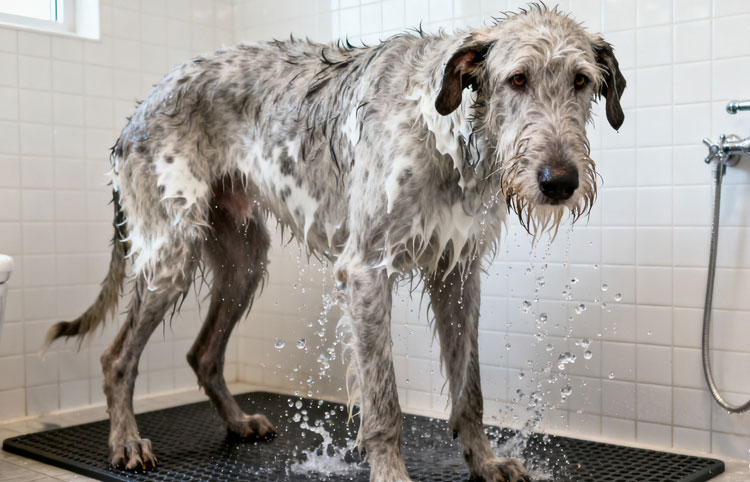
XI. Irish Wolfhound Grooming
1. Body Grooming:
(1) Daily Brushing: Spend a few minutes daily brushing your Irish Wolfhound. Start with a coarse brush, combing from head to tail to remove loose dead hair and surface dander, reducing shedding around the house. Follow with a soft bristle brush to remove surface dust. Finally, use a wide-tooth comb to thoroughly detangle areas prone to mats, such as the armpits and belly. For minor tangles, avoid pulling forcefully—gently work the comb through the mats.
(2) Matting Removal: For larger mats, avoid cutting directly with scissors, as this risks skin injury. Use a matting comb to gently separate the mat, or carefully insert scissors into the center of the mat and gently slice it apart, dividing the large mat into smaller sections for combing. Alternatively, spray some detangling spray or apply a small amount of vinegar to the mat. Wait until the mat softens before combing, which makes it easier to detangle without damaging the fur and prevents indentations from forming after combing.
(3) Combing and Trimming with a Slicker Brush: After removing mats, use a slicker brush to comb against the grain from the tips toward the roots to lift the fur. Then, brush with the grain from the head toward the hips to align the hair in one direction for a neater appearance. For show dogs, this step is crucial. After brushing, trim excessively long or uneven hair in small sections to achieve a more aesthetically pleasing overall look for the Irish Wolfhound.
2. Facial Grooming:
(1) Remove coarse stubble: Trim the coarse stubble around the muzzle to give the dog a clean, sharp appearance. Take care to avoid accidentally cutting the sideburns and head hair, as these are distinctive features of the Irish Wolfhound.
(2) Facial Grooming: After dust removal, use a wide-tooth comb to check for and eliminate matted knots. Facial grooming is relatively straightforward; appropriate trimming yields excellent results.
3. Paw Grooming:
(1) Trimming paw hair: Place the Irish Wolfhound’s paw flat on a surface. Trim along the edge of the paw. Then, grasp the leg and shake out the tufted hair. Hold the clippers vertically and trim to create a “puff” shape. Maintain a slight distance from the edge when cutting downward to avoid exposing the toes or making the paw appear too small.
(2) Interdigital Trimming: Insert the blade at an angle between the toes to trim, ensuring the foot appears compact overall. Simultaneously trim the tufts between the paw pads to maintain foot cleanliness.
admin
-
Sale!

Washable Pet Cooling Pad for Cats and Dogs
$10.99Original price was: $10.99.$9.99Current price is: $9.99. This product has multiple variants. The options may be chosen on the product page -
Sale!

Washable Cat Window Hammock Cooling Bed
$23.99Original price was: $23.99.$22.99Current price is: $22.99. -
Sale!
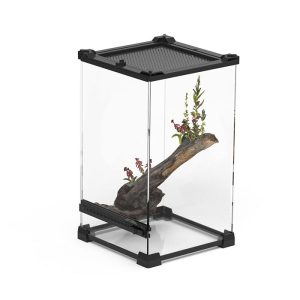
Tropical Amphibian Rainforest Tank, Lizard Cage
$38.99Original price was: $38.99.$36.99Current price is: $36.99. -
Sale!

Silent 4-in-1 Waterproof Charging Dog Hair Trimmer
$49.88Original price was: $49.88.$47.99Current price is: $47.99.
